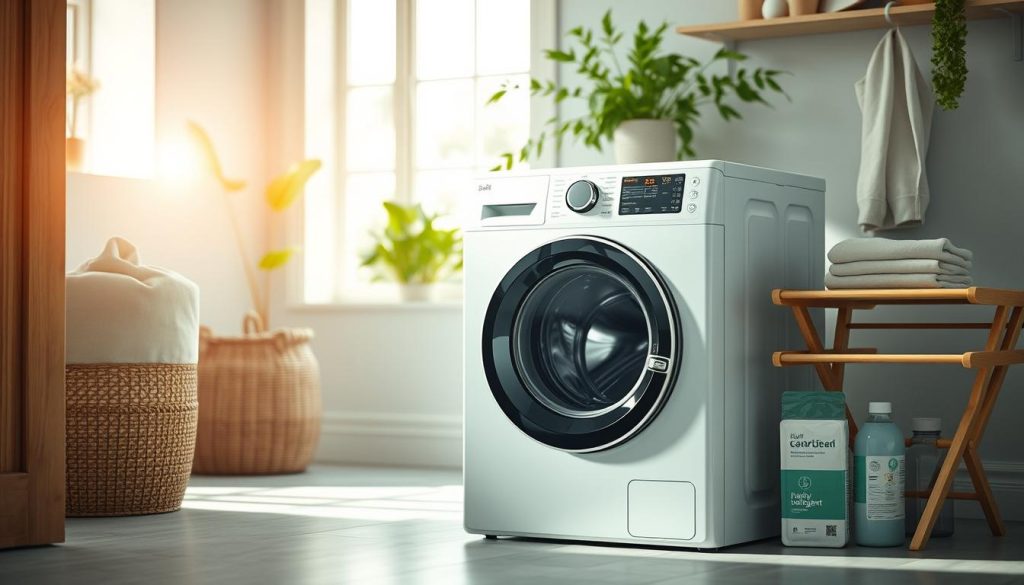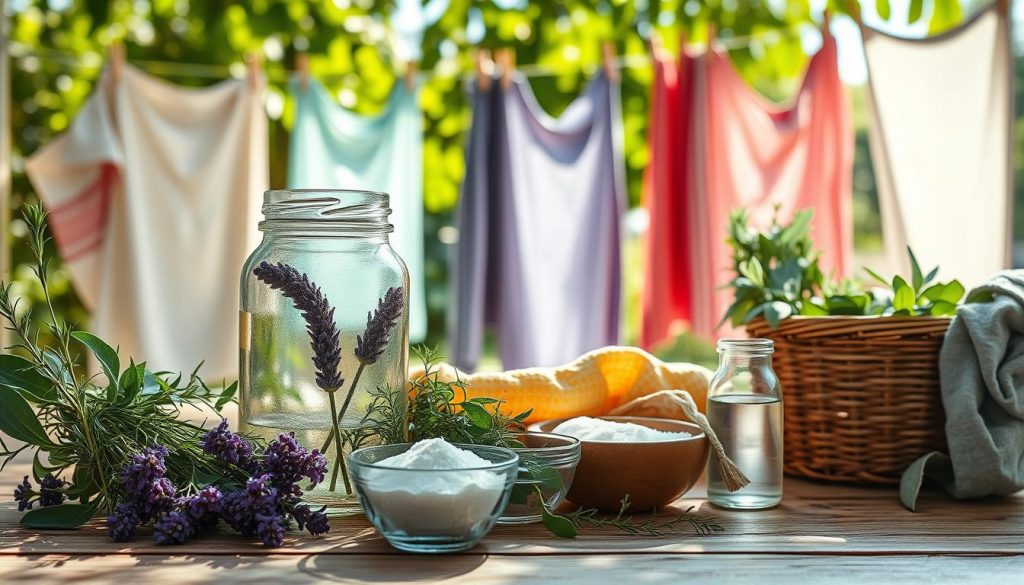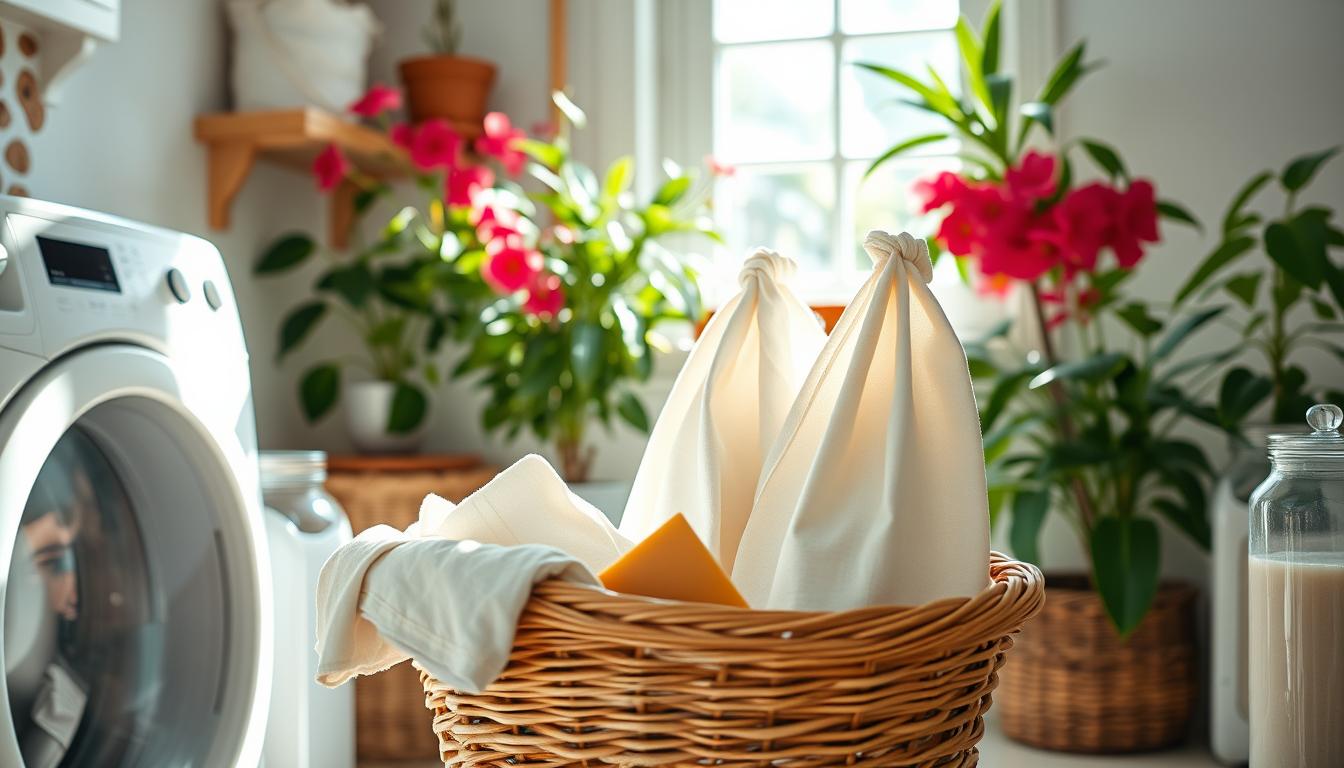I’m excited to share some game-changing tips for eco-friendly laundry. Exploring zero waste laundry practices has opened my eyes to sustainable fabrics and eco-friendly detergents. These can change your laundry routine.
In this guide, we’ll look at simple ways to keep your clothes clean while helping the planet. We’ll talk about choosing the right materials and finding alternatives to harsh chemicals. I’ll show you how to make your laundry day greener and more efficient.
Get ready to change your laundry habits and join the movement towards a more sustainable home. Let’s get started on making a difference, one load at a time!
Understanding Zero Waste Laundry Practices
Zero waste laundry is changing how we clean clothes. It’s great for those wanting to lessen their environmental footprint. Let’s explore what it means and why it’s becoming more popular.
What is zero waste laundry?
Zero waste laundry aims to cut down on waste in our cleaning. It involves using green detergents, avoiding single-use plastics, and picking sustainable fabrics. Making small changes, like using reusable dryer balls, can greatly reduce laundry waste.
Benefits of adopting eco-friendly laundry habits
Adopting zero waste laundry has many benefits. It reduces plastic pollution and water use. My energy bills have gone down since I started. Plus, eco-friendly products are kinder to clothes, making them last longer.
Common misconceptions about sustainable laundry
Some think sustainable laundry is pricey or doesn’t work. But, it’s not true. Eco-friendly products might cost more at first, but they last longer. Natural detergents clean just as well as regular ones. It’s about finding the right products and methods for you.
Understanding zero waste laundry helps us move towards a greener future. It’s about making progress, not being perfect. Every small change in laundry habits can make a big environmental difference.
Choosing Sustainable Fabrics for Your Wardrobe
I’m excited to share my journey into sustainable fabrics. As I started using zero waste laundry, I learned how important eco-friendly materials are. Let’s look at some great options that are good for our planet and your clothes.
Organic cotton is my top pick. It’s grown without harmful pesticides and uses less water than regular cotton. It feels soft on my skin and is great for everyday wear.
Bamboo fabric is another favorite. It grows fast without pesticides and needs little water. Bamboo clothes are comfy and breathable, perfect for any occasion.
Recycled polyester is also a hit. It’s made from plastic bottles, giving old waste a new life. I’ve found awesome activewear and outerwear made from this fabric.
| Fabric | Environmental Benefits | Best Uses |
|---|---|---|
| Organic Cotton | Pesticide-free, Less water usage | T-shirts, Underwear, Bedding |
| Bamboo | Fast-growing, Minimal water needs | Loungewear, Socks, Towels |
| Recycled Polyester | Reduces plastic waste, Energy-efficient | Activewear, Jackets, Bags |
Choosing these sustainable fabrics has made a big difference in my laundry. They need less washing and last longer. This fits perfectly with my zero waste laundry goals and cuts down on harsh detergents.
Eco-Friendly Detergents: Making the Switch
Switching to eco-friendly detergents has changed my laundry game. These products clean clothes well and are better for the planet. Let’s look at some cool alternatives to regular detergents.
Natural alternatives to traditional detergents
Eco-friendly detergents come in many forms. Soap nuts are berries that make natural soap when mixed with water. Castile soap, made from plants, is soft on clothes and the earth.
DIY laundry soap recipes
Making your own laundry soap is fun and saves money. Here’s a simple recipe I use:
- 1 cup washing soda
- 1 cup baking soda
- 1 cup grated castile soap
Just mix these and use 1-2 tablespoons per load. This homemade soap is kind to clothes and the planet.
Biodegradable cleaners for tough stains
For tough stains, I use biodegradable cleaners. Enzyme-based cleaners are great for organic stains like food and grass. White vinegar helps with odors and makes whites brighter.
| Stain Type | Eco-Friendly Solution |
|---|---|
| Grease | Baking soda paste |
| Red wine | Salt and club soda |
| Ink | Lemon juice |
Using eco-friendly detergents and DIY solutions has cut down my laundry’s harm to the environment. It’s a small step that makes a big impact.
Energy-Efficient Washing Techniques

I’m excited to share some game-changing energy-efficient washing techniques. They’ll help you save money and reduce your carbon footprint. By making a few simple adjustments, you can make a big difference in your home’s energy consumption.
Let’s start with temperature. Washing clothes in cold water is a key strategy for energy-efficient washing. It uses less energy than hot water cycles and still gets your clothes clean. For most loads, cold water works just fine.
Next, consider load size. Filling your washer to capacity maximizes efficiency. But don’t overstuff it! Clothes need room to move around for proper cleaning. This approach saves water and energy, supporting your zero waste laundry goals.
Using the right settings on your machine is crucial. Many modern washers have eco-friendly modes that optimize water and energy use. These settings might take longer, but they’re worth it for water conservation and energy savings.
- Use cold water for most loads
- Wash full loads, but don’t overstuff
- Choose eco-friendly machine settings
- Opt for high-spin cycles to reduce drying time
Remember, energy-efficient washing isn’t just about the wash cycle. High-spin settings wring out more water, cutting down on drying time and energy use. It’s a small step that makes a big impact on your overall laundry efficiency.
By incorporating these techniques into your routine, you’ll be well on your way to a more sustainable and cost-effective laundry practice. It’s amazing how these small changes can lead to significant water conservation and energy savings over time!
Zero Waste Laundry: Minimizing Environmental Impact
I’m excited to share some game-changing tips for minimizing our environmental impact through zero waste laundry practices. By making a few simple changes, we can significantly reduce our ecological footprint while keeping our clothes clean and fresh.
Reducing water consumption
Water conservation is key in zero waste laundry. I’ve found that washing full loads and using shorter cycles can drastically cut down on water usage. For lightly soiled clothes, a quick rinse often does the trick. Consider investing in a high-efficiency washing machine that uses less water per cycle.
Plastic-free laundry solutions
Embracing plastic-free laundry options has been a game-changer for me. I’ve switched to wool dryer balls instead of dryer sheets and use biodegradable detergent strips that come in paper packaging. These small changes have significantly reduced my plastic waste.
Repurposing and upcycling old clothes
Don’t toss those old clothes! I’ve discovered countless ways to give them new life. Cutting up worn-out t-shirts for cleaning rags or transforming jeans into trendy shorts are just a few ideas. For clothes beyond repair, I look for textile recycling programs in my area.
| Zero Waste Laundry Practice | Environmental Impact |
|---|---|
| Using cold water | Reduces energy consumption by up to 90% |
| Hang-drying clothes | Saves 700 lbs of carbon emissions annually |
| Choosing eco-friendly detergents | Prevents harmful chemicals from entering waterways |
By implementing these zero waste laundry practices, I’ve seen a dramatic reduction in my household’s environmental impact. It’s amazing how small changes can lead to big results in water conservation and plastic-free living.
Natural Fabric Softeners and Their Benefits

I’ve found that natural fabric softeners are a big help for zero waste laundry. They make clothes soft and are better for the planet. Let’s look at some options and their benefits.
Vinegar is my top choice for softening clothes naturally. It’s affordable, works well, and easy to find. I add a cup of white vinegar to the rinse cycle. It softens clothes, gets rid of odors, and doesn’t leave a residue. Plus, it’s kinder to fabrics than regular softeners.
Essential oils are another excellent choice. I mix a few drops with water in a spray bottle and lightly mist my clothes before drying. Lavender oil is my favorite for its calming scent and natural antibacterial properties.
Baking soda is great for laundry too. It softens water, balances pH levels, and helps remove tough stains. I use it with my eco-friendly detergents for extra cleaning power.
| Natural Softener | Benefits | Usage |
|---|---|---|
| Vinegar | Softens, deodorizes, removes residue | 1 cup in rinse cycle |
| Essential Oils | Adds fragrance, antibacterial | Few drops in spray bottle with water |
| Baking Soda | Softens water, balances pH, stain removal | 1/2 cup with detergent |
By using these natural fabric softeners, I’ve cut down on chemical products. It’s a small change that makes my home more sustainable and eco-friendly.
Drying Clothes the Eco-Friendly Way
Drying clothes is a big part of our laundry routine. Using eco-friendly methods saves energy and helps with zero waste laundry. Let’s look at some good ways to dry clothes that save water.
Air-drying techniques
Air-drying is a simple and effective way to dry clothes without electricity. I hang clothes outside when it’s nice. For drying inside, I use a foldable rack near a window or fan. This keeps clothes in good shape and uses less energy.
Energy-efficient dryer usage
When air-drying isn’t possible, I use energy-efficient dryers. These use less power and have moisture sensors to avoid over-drying. I always clean the lint filter before each use to help airflow and cut drying time.
Innovative drying solutions for small spaces
Even in small homes, we can dry clothes eco-friendly. I use wall-mounted drying racks and over-the-door hangers. These save space and let clothes dry well without taking up too much room.
| Drying Method | Energy Usage | Space Required | Drying Time |
|---|---|---|---|
| Outdoor Line Drying | None | Large | 2-4 hours |
| Indoor Rack Drying | None | Medium | 8-24 hours |
| Energy-Efficient Dryer | Low | Small | 30-60 minutes |
| Wall-Mounted Rack | None | Small | 6-12 hours |
Laundry Waste Reduction Strategies

I’m always searching for ways to lessen my environmental impact, especially with laundry. Zero waste laundry is crucial for reducing our carbon footprint. Let’s look at some effective laundry waste reduction strategies that you can use at home.
Sorting clothes properly is the first step in reducing laundry waste. By separating clothes by color and fabric type, we can avoid extra washes. This simple habit helps a lot in achieving zero waste laundry goals.
Fixing clothes instead of throwing them away is also key. Learning basic sewing can help us mend small tears or replace buttons. This keeps our favorite clothes in use longer.
Choosing sustainable fabrics for our clothes is a great way to reduce laundry waste. These materials often need less washing and last longer. This fits perfectly with zero waste laundry principles.
| Sustainable Fabric | Benefits | Care Tips |
|---|---|---|
| Organic Cotton | Biodegradable, less water-intensive | Wash in cold water, air dry |
| Hemp | Durable, antimicrobial | Gentle cycle, avoid high heat |
| Tencel | Moisture-wicking, less prone to wrinkling | Machine wash cold, tumble dry low |
Mindful consumption is important in reducing laundry waste. Buying quality items that last longer and avoiding fast fashion trends helps a lot. Remember, the best garment is the one you already own!
Water Conservation in Your Laundry Routine
Water conservation is key in zero waste laundry. I’ve found ways to use less water and still keep clothes clean. Let’s look at some smart methods to change your laundry habits.
Greywater Systems for Laundry
Greywater systems are a big help for saving water. They take water from your washing machine and use it for other things, like watering plants. Using a greywater system has really cut down my water use at home.
Low-Water Washing Machines
Getting an energy-efficient washing machine helps a lot. Front-loading machines use half the water of old top-loaders. They clean well and save water too.
Collecting and Reusing Rinse Water
I also collect rinse water from my washing machine. It’s clean enough for cleaning floors or washing cars. It’s a simple way to save water without needing special gear.
| Water-Saving Method | Potential Water Savings |
|---|---|
| Greywater System | Up to 40 gallons per load |
| Low-Water Washing Machine | 15-25 gallons per load |
| Reusing Rinse Water | 10-20 gallons per load |
By using these water-saving tips, I’ve cut my water use a lot. It’s surprising how much difference small changes can make for the planet and your wallet.
Innovative Eco-Friendly Laundry Products
I’m excited to share some groundbreaking eco-friendly laundry products. They’re changing the game for sustainable households. These innovations make plastic-free laundry and zero waste laundry practices more accessible than ever.
The microfiber-catching laundry ball is a standout product. It traps tiny plastic fibers shed from synthetic clothes during washing. This prevents them from entering our waterways. It’s a simple yet effective tool for reducing microplastic pollution.
For those seeking eco-friendly detergents, laundry sheets are a game-changer. These thin, dissolvable sheets contain concentrated cleaning power without the need for plastic packaging. They’re lightweight, easy to store, and perfect for travel.
Wool dryer balls are another fantastic innovation. These natural alternatives to dryer sheets reduce drying time, soften clothes, and can be reused for years. Add a few drops of essential oil for a natural, customizable scent.
- Soap nuts: Natural, reusable berries that release soap when agitated in water
- Stain removal bars: Solid, package-free alternatives to liquid stain removers
- Guppy Friend washing bag: Captures microfibers from synthetic clothes during washing
These eco-friendly laundry products not only reduce waste but also perform exceptionally well. By incorporating them into our routines, we can maintain clean clothes while minimizing our environmental impact.
Creating a Sustainable Laundry Room Setup
I’m excited to share how you can make your laundry room eco-friendly. Start with energy-efficient washing machines. They use less water and electricity, perfect for zero waste laundry.
Look for ENERGY STAR certified models. They save energy and reduce environmental impact.
Storage solutions are crucial for sustainable laundry. Use glass jars or metal containers for detergents and essentials. This reduces plastic waste and adds style.
For sorting clothes, choose bamboo or sustainably harvested wooden hampers. These materials are durable and fit any decor.
To encourage zero waste, set up a mending area. Keep a sewing kit for small repairs. This extends your clothes’ life and cuts down on waste.
Also, create a space for air-drying delicate items. This saves energy and keeps your clothes in good condition.
Good lighting is also important. Install LED bulbs to brighten your room while using less energy. With these changes, your laundry room will be efficient and sustainable.
It’s amazing how small changes can make a big difference in our daily lives and the environment.

